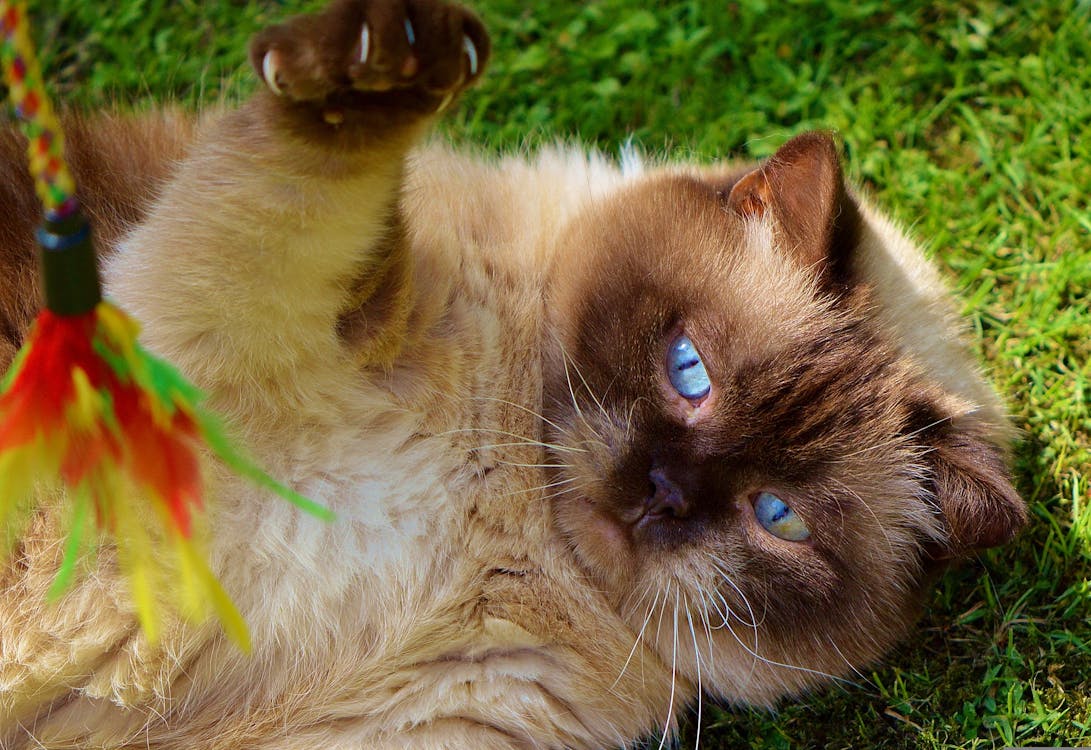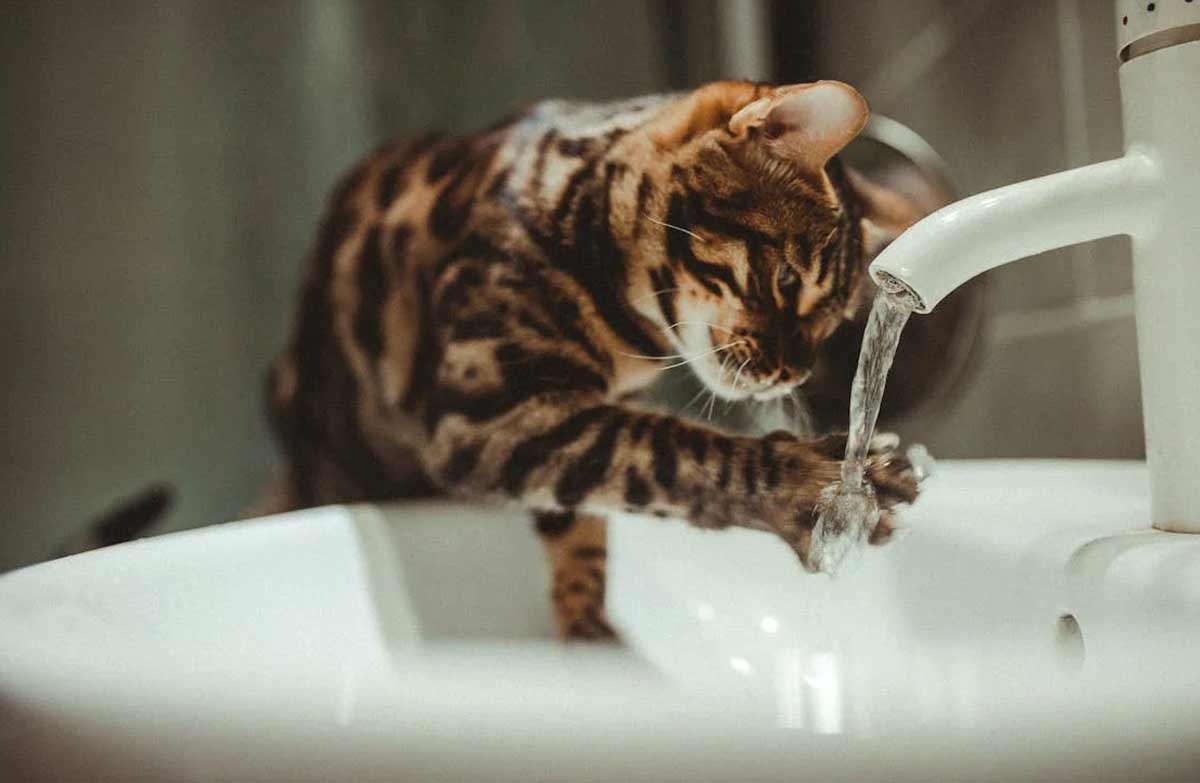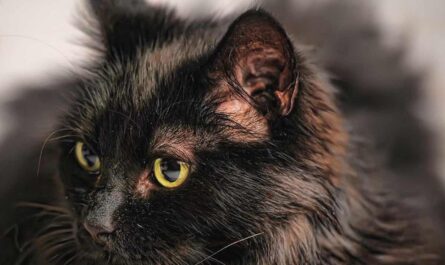Cat won’t let me trim nails, what to do? Anyone who shares their life with a feline friend knows the occasional wrestling match that erupts when it’s nail trim time. Visions of a frantic cat contorting itself into impossible positions, Houdini-like escapes, and the distinct feeling of being outsmarted by a creature half your size are all par for the course. But fear not, fellow cat owners! This battle with the miniature murder mittens doesn’t have to be an epic (and slightly embarrassing) showdown.
This guide is here to be your paw-sitive reinforcement, transforming you from a nail-trimming novice to a confident feline manicurist (well, almost). We’ll explore the importance of regular nail trims for your cat’s health and well-being, delve into the reasons behind their aversion to the experience, and equip you with a toolbox of techniques to make nail trims a breeze (or at least a less dramatic affair). So, grab your cat’s favorite treats, take a deep breath, and let’s transform those razor-sharp claws into purrfectly blunt little nubs.
Cat won’t Let Me Trim Nails: Your Roadmap to a Stress-Free Nail Trim
Here’s a sneak peek at the exciting adventures that await you on this journey to becoming a nail trim pro:
-
The Purr-fect Reasons for Regular Trims: We’ll delve into the benefits of keeping your cat’s claws neatly trimmed, from preventing snags on furniture to safeguarding your skin.
-
Understanding Your Feline Friend: We’ll explore the psychology behind a cat’s fear of nail trims, identifying potential triggers, and how to address them.
-
Desensitization: The Key to Calm: Discover techniques to gradually introduce your cat to the sight, sound, and touch associated with nail trims, transforming a stressful experience into a positive one.
-
Clippers at the Ready: A Step-by-Step Guide: We’ll provide a detailed, step-by-step guide on trimming your cat’s nails, including proper tool selection, safe restraint methods, and tips for a smooth process.
-
Beyond the Clippers: Alternative Trimming Options: For the truly claw-somely resistant felines, we’ll explore alternative trimming methods like scratching posts and soft paws.
-
A Positive Paw-fternoon: Learn aftercare tips to make nail trims a positive experience for both you and your cat, promoting a happy and healthy bond.
Claws for Concern: The Importance of Regular Nail Trims
Anyone who shares their life with a feline friend knows the joy (and occasional chaos) that comes with those adorable little paws. But those playful swipes and curious climbs can leave a trail of destruction on your furniture and potential ouch moments for you and your cat if their claws become overgrown. Regular nail trims are an essential part of responsible cat care, offering a multitude of benefits for both you and your furry companion.
Preserving Your Prized Possessions (and Sanity!):
Let’s face it, cats are natural explorers, and their claws are their built-in climbing tools. Unfortunately, those sharp points can wreak havoc on your furniture. Imagine your favorite armchair transformed into a shredded masterpiece, or your expensive drapes sporting a network of snags. Regular nail trims help keep your cat’s claws at a manageable length, minimizing the risk of them damaging your cherished belongings. Think of it as a preventative measure for your wallet (and a sigh of relief for your interior design dreams!).
But the benefits extend beyond protecting your furniture. Overgrown claws can also pose a threat to you during playtime. A playful swipe with an excessively long nail can leave an unintended scratch, turning a cuddle session into a hiss-fest. Regular nail trims ensure playtime remains a fun and positive experience for both you and your cat, fostering a strong bond built on trust and mutual respect.
Keeping Those Paws Happy and Healthy:
Imagine trying to walk with long, sharp nails digging into your toes – not exactly comfortable, right? The same goes for your cat. Overgrown nails can curl inwards, becoming ingrown. This painful condition can cause inflammation, and bleeding, and even make walking difficult for your cat. Regular nail trims prevent ingrown nails, keeping your cat’s paws comfortable and healthy.
Furthermore, overgrown nails can make it difficult for your cat to retract their claws completely. This can lead to them getting caught on carpets or other surfaces, causing them distress. Regular nail trims ensure your cat can retract their claws comfortably, allowing them to move freely and explore their environment with confidence.
Promoting a Purrfectly Active Lifestyle:
Cats are natural climbers and scratchers. These behaviors are not just playful antics; they’re essential for exercise, stress relief, and marking their territory. However, overgrown nails can make these activities uncomfortable for your cat. Imagine trying to climb a scratching post with long, dull claws – not exactly the most efficient way to sharpen those hunting instincts!
Regular nail trims keep your cat’s claws sharp and pointed, allowing them to climb, scratch, and explore their environment with ease. This promotes a healthy and active lifestyle for your feline friend, keeping them physically and mentally stimulated. Think of it as a small investment in your cat’s overall well-being and happiness.
Decoding the Discontent: Why Nail Trims Can Turn into a Clawsome Catastrophe
Does the mere mention of “nail trim” send your feline friend scrambling under the bed? If so, you’re not alone. Many cat owners find themselves locked in an epic battle of wills when it comes to claw care. But before you throw in the towel (or the catnip mouse!), let’s delve into the reasons behind your cat’s aversion to nail trims. Understanding the “why” behind the resistance can equip you with the tools to navigate this potentially stressful situation for both you and your furry companion.
Echoes of the Wild: The Evolutionary Perspective
Cats are descendants of wild hunters, honed for stealth and independence. Imagine a majestic lioness patrolling the savanna – having her paws restrained would be a significant vulnerability in the wild. This deeply ingrained instinct to protect their paws can translate into strong resistance when it comes to nail trims. Even the gentlest restraint might trigger a fight-or-flight response in your domesticated feline, leading to hissing, swatting, or a desperate escape bid.
Shadows of the Past: The Impact of Negative Experiences
Sometimes, a seemingly harmless nail trim can turn into a traumatic experience for a cat. Perhaps a previous clipping session was too rough, causing them pain or discomfort. This negative association can linger, making them dread future nail trims. If you adopted your cat from a shelter or rescue, there’s a chance they might have had an unpleasant experience with nail trims in the past. Be patient and understanding, and focus on building trust before attempting another nail trim.
Facing the Fearsome Unknown: The Mystery of Clippers and Claws
Cats are creatures of habit, and anything unfamiliar can be a source of apprehension. The sight (and sound) of nail clippers might be a complete mystery to your feline friend. The cold metal against their sensitive paws can be startling, and the unfamiliar sensation of clipping can be downright scary. Remember, from your cat’s perspective, these clippers are strange contraptions approaching their most vulnerable points – their paws!
By understanding these underlying reasons for your cat’s resistance, you can approach nail trims with more empathy and develop strategies to make the experience less stressful for everyone involved. The next section will explore various techniques to transform nail trims from a battlefield to a purrfectly positive experience.
Taming the Tiger: Desensitization Techniques for Stress-Free Trims
Let’s face it, trimming your cat’s claws can sometimes feel like wrestling a miniature tiger. Those sharp little daggers can wreak havoc on furniture and unsuspecting ankles, making regular nail trims a necessity. However, the prospect of holding down a squirming, unhappy feline can leave even the most seasoned cat owner feeling defeated. Fear not, fellow cat companions! This section delves into the power of desensitization techniques, transforming stressful nail trims into a positive and collaborative experience for both you and your furry friend.
Start Early and Sow the Seeds of Success
Just like building a strong foundation for a house, introducing nail trims from a young age sets your kitten up for a lifetime of nail-trimming acceptance. The earlier you begin this process, the more likely your kitten will associate nail trims with calmness and even positive reinforcement. Here’s how to get started:
-
Gentle Handling: Even before attempting an actual trim, get your kitten comfortable with having their paws touched. Start by gently stroking their legs and paws, offering praise and a yummy treat for their patience. Gradually increase the duration and intensity of the handling, mimicking the motions you’ll use during a trim.
-
Positive Reinforcement is Your Secret Weapon: Cats are incredibly food-motivated creatures. Use this to your advantage! During these desensitization sessions, keep a steady stream of small, high-value treats on hand. Reward your kitten with a treat for calm behavior when you touch their paws or even bring the clippers near them. This positive association will make future trims much less stressful.
Focus on the Paws, Not the Claws (Just Yet!)
Many cat owners make the mistake of jumping straight into clipping the nails, which can lead to immediate resistance. Instead, take a step back and focus on desensitizing your cat to having their paws handled entirely. Here’s a step-by-step approach:
-
Make it a Relaxing Ritual: Choose a calm and quiet environment for these desensitization sessions. Perhaps a sunny spot on the floor or your lap can become your designated “nail trim zone.” Having a consistent and relaxing environment helps your cat feel safe and secure.
-
Start Slow and Gentle: Gently lift one of your cat’s paws and hold it for a few seconds. Reward them with a treat for tolerating this new sensation. Gradually increase the duration you hold their paw, eventually working your way towards gently extending each claw.
-
Respect Their Boundaries: If your cat seems stressed or pulls their paw away, don’t force it. End the session on a positive note with a treat and praise for their cooperation. Remember, desensitization is a gradual process, built on trust and positive experiences.
The Power of Play: Turning the Tables on Trimming Anxiety
Sometimes, the best way to introduce a potentially scary object (those dreaded clippers!) is through the power of play. Here’s how to incorporate the clippers into your cat’s playtime routine:
-
Make it Fun and Engaging: Leave the clippers lying on the floor during playtime sessions, alongside some of your cat’s favorite toys. This allows them to investigate the clippers at their own pace, associating them with a positive play experience.
-
The Sound of Fun, Not Fear: Gently click the clippers open and closed while playing with your cat. If they seem startled at first, toss a favorite toy to redirect their attention. Over time, the clicking sound will become less threatening and more associated with playtime.
-
Reward Curiosity: If your cat shows any curiosity towards the clippers by sniffing or batting them, offer them a treat for their bravery! This positive reinforcement encourages them to explore the clippers further, diminishing any initial fear.
By incorporating these desensitization techniques into your routine, you can transform nail trims from a stressful battle into a positive and collaborative experience for both you and your feline friend. Remember, patience, positive reinforcement, and a calm approach are key to setting the stage for stress-free trims in the future.
Claws on Camera: A Step-by-Step Guide to Trimming Your Cat’s Nails
Clipping your cat’s nails might seem like an intimidating task, especially if your feline friend isn’t exactly thrilled about the prospect. But fear not, fellow cat guardian! With a little preparation, patience, and the right approach, you can transform nail trimming from a battle of wills into a positive bonding experience for both of you. So, grab your camera (to capture those adorable pre-trim moments, of course!), and let’s delve into a step-by-step guide to keep those claws nice and neat.
Gather Your Supplies: A Cat Manicurist’s Toolkit
Before you embark on your nail-trimming adventure, assemble your essential feline manicure kit:
-
Cat Nail Clippers: Unlike human nail clippers, cat nail clippers are specifically designed for the smaller, more delicate claws of our feline companions. Opt for sharp clippers that will make a clean cut, preventing painful splitting or crushing of the nail.
-
Styptic Powder: Accidents happen, even to the most seasoned cat manicurists (that’s you!). Styptic powder is a handy tool to have on hand in case of a nick to the quick, the pink, sensitive area inside the nail. This powder helps to stop minor bleeding quickly and painlessly.
-
Treats, Treats, and More Treats!: Positive reinforcement is key to creating a positive association with nail trimming. Stock up on your cat’s favorite treats – little nibbles of tuna, crunchy catnip-infused delights, or any other irresistible morsel that will keep your feline friend happy and cooperative throughout the process.
Bonus Tip: Consider using a nail file to smooth out any rough edges after clipping. This will not only provide added comfort for your cat but also prevent them from snagging their nails on furniture or your favorite sweater.
Creating a Calm Environment: Setting the Stage for Success
Just like humans, cats thrive in peaceful environments. To set the stage for a successful nail-trimming session, choose a quiet, well-lit area free from distractions. Perhaps a sunny spot on the living room floor or a familiar corner of your bedroom would be perfect.
If your cat tends to be on the more nervous side, consider enlisting the help of a friend or family member to assist with gentle restraint. Remember, the goal is to create a safe and secure environment, not a wrestling match!
The Art of Restraint: Holding Your Cat with Confidence (and Comfort!)
Now comes the moment of truth – holding your cat for the nail trim. There are two popular methods you can try, depending on your cat’s personality and comfort level:
-
The Towel Burrito Technique: This method works well for cats who find security in being swaddled. Gently wrap your cat in a soft towel, leaving only one paw exposed for nail trimming. This method provides a sense of calm and security for some cats, but be mindful not to restrict their breathing in any way.
-
Lap Positioning with Gentle Restraint: If your cat enjoys cuddling, you can try positioning them comfortably on your lap. Use one hand to gently hold their paw, while the other hand provides support for their body. The key here is gentle restraint – you want your cat to feel secure, not trapped.
Remember: Always prioritize your cat’s comfort and well-being. If they become overly stressed or agitated, take a break and try again later. Positive reinforcement is key, so shower your cat with praise and treats throughout the process.
Identifying the Quick: Avoiding the Pinch Point
Before you make the clip, it’s crucial to locate the quickly. The quick is the pink, blood vessel-rich area inside the cat’s nail. Accidentally clipping the quick can be painful for your cat and cause bleeding.
The easiest way to identify the quick is to hold your cat’s paw up to the light. You’ll see the pink area extending down the center of the nail. Focus on clipping the white, tip portion of the nail, well away from the quick.
Tip: If you’re unsure about where to clip, it’s always better to err on the side of caution and take smaller trims.
Making the Cut: A Snip, a Treat, Repeat
Now comes the moment of truth – the actual clipping! Here’s how to ensure a smooth and painless experience:
-
Hold the clippers perpendicular to the nail. Imagine the nail as a clock face, and aim to clip at a 45-degree angle from the tip, avoiding the quick.
-
Make small, clean cuts. Don’t attempt to take off a large chunk of nail in one go. Instead, focus on making small, precise snips with your sharp clippers. This will help prevent accidental nicks and keep your cat comfortable.
-
Praise and Reward: After each successful clip, shower your cat with praise and a delicious treat! This positive reinforcement helps them associate nail trimming with a happy experience, making future sessions much smoother.
-
Take Breaks: If your cat becomes restless or fidgety, take a short break. Never force them to continue if they’re feeling stressed. Patience and positive reinforcement are key!

Addressing Accidents: Minor Mishaps and How to Handle Them
Even the most experienced cat manicurist might encounter an occasional mishap. If you accidentally nick the quick, don’t panic! Here’s how to handle the situation:
-
Styptic Powder to the Rescue: Apply a small amount of styptic powder to the tip of the bleeding nail using a clean cotton swab. Styptic powder is a clotting agent that will help stop minor bleeding quickly and painlessly.
-
Comfort and Reassurance: Hold your cat gently and speak in soothing tones to reassure them. The bleeding should stop within a few minutes.
-
Monitor the Nail: Keep an eye on the affected nail in the following days. If the bleeding persists or the nail seems infected, consult your veterinarian.
Remember: Accidents happen. The most important thing is to stay calm, handle the situation gently, and prioritize your cat’s comfort.
Beyond the Basics: Tips for Success and a Positive Experience
Here are some additional tips to ensure a successful and positive nail-trimming experience for both you and your cat:
-
Start Early: Introduce your cat to nail trimming when they’re young. Even gentle handling of their paws can help them become accustomed to the process.
-
Make it a Routine: Schedule regular nail trims, ideally every few weeks, to prevent the nails from becoming overgrown and uncomfortable for your cat.
-
Positive Reinforcement is Key: Reward your cat with praise, treats, and cuddles throughout the entire process. This positive reinforcement helps create a happy association with nail trimming.
-
Seek Professional Help: If your cat becomes overly stressed or aggressive during nail trimming, don’t hesitate to seek help from a veterinarian or professional groomer. They have the experience and expertise to handle even the most challenging feline personalities.
By following these tips and approaching nail trimming with patience and positive reinforcement, you can transform it from a dreaded chore into a positive bonding experience for you and your furry companion. Remember, a little preparation and a lot of love go a long way in keeping those claws nice and trim, your furniture scratch-free, and your cat happy and healthy!
Alternative Avenues: Trimming Techniques for Tenacious Talons
Let’s face it, some feline friends are simply not fans of the whole nail-trimming business. Their claws might retract faster than a magician’s disappearing act, and the mere sight of clippers can send them dashing for the hills (or, more likely, under the bed). But fear not, there are alternative avenues to explore for keeping those kitty claws under control.
Enlist Professional Help: Calling in the Cavalry
Sometimes, the best course of action is to enlist the help of a professional. Veterinarians and experienced groomers are well-versed in handling even the most wiggly and determined felines. They have the training and experience to ensure a safe and stress-free nail trim for your cat.
Here are some situations where seeking professional help might be a good idea:
-
Feline Houdinis: If your cat possesses escape artistry worthy of a Hollywood action movie, a professional can provide a safe and secure environment for the procedure.
-
Senior Kitties: As cats age, their bodies might become less flexible, making nail trimming more challenging. A professional can handle them with the gentleness and care they deserve.
-
Medical Conditions: Certain medical conditions, like arthritis, can make nail trimming uncomfortable for your cat. A veterinarian can assess your cat’s specific needs and recommend the safest approach.
Remember: Seeking professional help is not a sign of defeat; it’s a sign of responsible pet ownership. A veterinarian or groomer can not only trim your cat’s nails but also offer valuable advice on feline behavior and overall health.
Embrace the Grind: Exploring Nail Grinders
For some cats, the clicking sound of clippers might be the source of their anxiety. If that’s the case, consider exploring a nail grinder as an alternative. Nail grinders use a rotating wheel to gently buff and shorten the nails, offering a smoother and potentially less stressful experience for your feline friend.
Here are some things to keep in mind when using a nail grinder:
-
Start Slow: Introduce the grinder gradually, letting your cat get accustomed to the sound and sensation before attempting an actual nail trim.
-
Positive Reinforcement: Shower your cat with praise and treats throughout the process to create a positive association with the grinder.
-
Grinding Technique: Hold the grinder gently against the tip of the nail and use short, controlled motions to avoid overheating the nail.
Tip: Nail grinders come in various models, with some being battery-operated and others electric. Choose one that feels comfortable and easy to handle for you.
Scratch Post Strategies: Natural Nail Buffing
Our feline companions have an instinct to scratch, and thankfully, this behavior can actually help keep their nails trimmed! Strategically placed scratching posts can become your secret weapon in the battle against overgrown claws. RPM 3.0 – 60% CONVERSION & Money for Affiliate Marketing
Here’s how to make scratching posts even more appealing to your cat:
-
Variety is the Spice of Life: Offer a variety of scratching textures, from sisal rope to cardboard to carpeted surfaces. This caters to your cat’s individual preferences and keeps them engaged.
-
Location, Location, Location: Place scratching posts in high-traffic areas where your cat likes to spend time. This makes scratching a convenient and readily available option for them.
-
Vertical vs. Horizontal: Provide both vertical and horizontal scratching options to accommodate your cat’s natural scratching preferences.
By encouraging your cat to use scratching posts regularly, you can help them wear down their nails naturally, reducing the need for frequent clipping sessions.
Soft Paws for the Win: A Temporary Solution
Soft paws are tiny, vinyl caps that can be glued onto your cat’s nails. These caps act as a temporary solution for cats who simply cannot tolerate nail trims. They are particularly helpful for situations where excessive scratching might be causing damage to furniture or your own skin.
Here are some things to keep in mind about soft paws:
-
Application: Applying soft paws requires some dexterity and patience. You might want to enlist the help of a friend or veterinarian for the first attempt. Cat accessories on Amazon
-
Temporary Fix: Soft paws typically need to be replaced every few weeks as your cat’s nails grow. They are not a permanent solution, but they can offer a temporary reprieve from nail trimming woes.
-
Not for Everyone: Some cats might not tolerate having soft paws applied to their nails. Observe your cat’s behavior and discontinue use if they seem distressed.
Remember, soft paws are a temporary solution, and regular nail trimming should still be the ultimate goal. However, they can be a valuable tool in certain situations.
Other Interesting Articles
- How To Take Care of A Baby Kitten 2 Weeks Old: 6-Step Guide
- 20 Famous People and Legends Who Loved & Had Pet Cats
- How To Tell If A Cat is Male/Boy or Female/Girl: Tips, Guide
- A Guide to Socializing Shy, Frightened, or Traumatized Cats
- How to Stop A Cat From Spraying Indoors: Home Remedies
- How to Help Cats Get Along with a Kitten Step-By-Step
- How To Tell If Your Cat Has A Triple Coat: 7 Simple Steps
- How To Tell If Your Cat Has Down Syndrome: Signs & Myths
- 11 Signs Your Cat is a Girl: Tips To Distinguish A Female Cat
- Petting A Shy Cat: A How-To Guide, Tips, Dos, Don’ts, FAQs
- How To Tell If Your Cat Has Fleas: Best Tips To Take Care
- How To Tell If Your Cat Can’t Hear: 10 Tips To Help A Deaf Cat
- Why is My Cat Making A Weird Vibrating Noise: What To Do
- How To Tell If A Shy Cat Likes You: 14 Signs To Observe
- How To Stop A Cat From Spraying Outside: 20 Tips To Try
- How To Tell If My Cat is in Pain After Surgery: 17 Implied Signs
- How to Take Care of A Kitten For the First Time: 20 Tips
- 20 Prohibited Things You Should NEVER Do To Your Pet Cat
- What to Know Before Getting a Second Cat: Tips & Guide
- What Scents and Smells Do Cats Hate? How To Deal With



